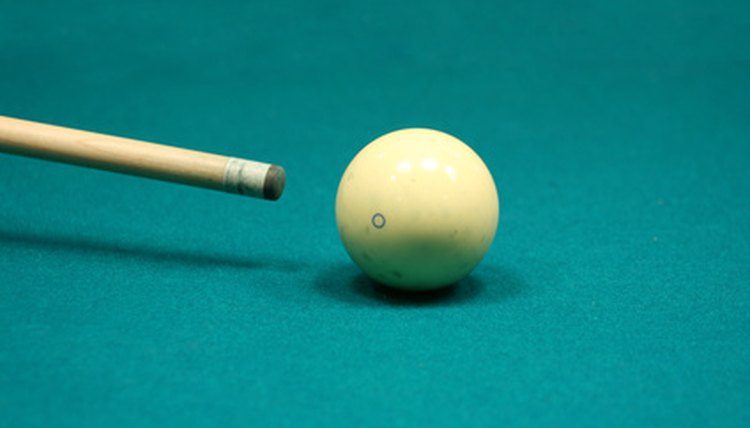How to Restore Cue Sticks

Line up and make the perfect ricochet pool shot, and you could have the whole pool hall cheering your name. Pool is a game of precision and accuracy, and while practice makes perfect, the player can only be as good as his tool. Pool cues are specially designed for aerodynamics and accuracy. However, amateurs attempting to repair or refinish their cue sticks can cause severe damage to the stick’s balance and shape, losing accuracy. Take precautions when restoring your cue to stay on top of your game.
Wipe the surface of the cue stick with a clean towel, removing all surface dirt, dust, chalk and oil. Do not disassemble your stick for the restoration process.
Burnish the stick with an undyed leather cloth. Rub evenly all the way up and all the way down the full stick so that you contact each section of the stick with the exact amount of pressure. This cloth will create friction on the surface, which can help to repair minor nicks. The friction also closes some of the pores in the wood surface, making the stick more dirt-resistant.
Inspect the cue stick for or cuts that have not disappeared after burnishing. Apply two to three drops of water to these areas and burnish again. The water combined with the friction from the burnishing can help to draw out the wood, evening out damaged areas.
Sand the cue stick only if absolutely necessary to remove damaged areas. Wrap a piece of fine-grit sandpaper, preferably 800- or 1,500-grit, around a sanding block. Lightly sand all the way up and down the shaft so the sanding is even. Do not concentrate on one area, even if there is only one nick or scratch; sanding in one area results in changing the shape of the stick.
Sand the tip of the pool stick with fine-grit sandpaper to achieve the smooth-edged, mushroom shape. Burnish it with the leather to restore smoothness.
Apply a thin layer of cue wax to the shaft. A variety of products are available for this purpose; follow all specific product instructions regarding application methods. The wax will restore the cue’s shine and will help to protect it from future damage.
Tips
When burnishing your cue stick with leather, it is speed, not power, that helps to repair nicks and shine the wood surface. For best results, move quickly up and down the shaft without applying too much pressure. Take care not to damage your ferrule when you sand the tip of the cue stick. Scratches in the ferrule can result in gathering dust, chalk and dirt, which can change the way the cue strikes the ball. If you have to replace the ferrule on your cue stick, consult with a professional cue maker or restorer. Different manufacturers use different connections for the ferrules, and trying to remove or add a ferrule incorrectly can ruin your stick.
Warnings
Serious nicks, cuts or other damage to the shaft require repair by a professional woodworker or cuemaker; attempting complicated repairs yourself can result in unbalancing or further damaging the cue.
Tips
- When burnishing your cue stick with leather, it is speed, not power, that helps to repair nicks and shine the wood surface. For best results, move quickly up and down the shaft without applying too much pressure.
- Take care not to damage your ferrule when you sand the tip of the cue stick. Scratches in the ferrule can result in gathering dust, chalk and dirt, which can change the way the cue strikes the ball.
- If you have to replace the ferrule on your cue stick, consult with a professional cue maker or restorer. Different manufacturers use different connections for the ferrules, and trying to remove or add a ferrule incorrectly can ruin your stick.
Warnings
- Serious nicks, cuts or other damage to the shaft require repair by a professional woodworker or cuemaker; attempting complicated repairs yourself can result in unbalancing or further damaging the cue.
Writer Bio
Samantha Volz has been involved in journalistic and informative writing for over eight years. She holds a bachelor's degree in English literature from Lycoming College, Williamsport, Pennsylvania, with a minor in European history. In college she was editor-in-chief of the student newspaper and completed a professional internship with the "Williamsport Sun-Gazette," serving as a full-time reporter. She resides in Horsham, Pennsylvania.
